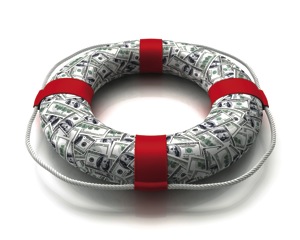
All working adults should have an emergency fund. It is that important! In fact, I believe it is the very first thing to get in place once out of school and working full-time.
An emergency fund is cash set aside in a savings account for those unexpected expenses and life events that inevitably occur. An emergency fund pays your rent when you lose a job. It pays for critical car repairs. Or it covers the deductible on your health insurance if you require medical care.
Unfortunately, about half the population does not have any kind of emergency fund. They live paycheck to paycheck. When the unexpected eventually happens (and it always will), the only option is to borrow money from family and friends or use credit cards.
The number one reason people start the downward spiral into credit card debt is due to an unexpected expense that could only be paid with credit. It’s usually the only option when you don’t have an emergency fund.
Once there’s a credit card balance, it’s easy to justify that a few more small purchases won’t add much to your existing balance. A few more impulse purchases later, and next thing you know there’s a huge balance on your credit card at a 24.99 percent interest rate and you can only afford to make the minimum payment. Using credit cards leads down a very slippery path.
Now that you have an idea why an emergency fund is so important, let’s get into the details. Here are the three main components of an emergency fund:
It should be large enough to cover three to six months of non-discretionary living expenses (housing, food, etc).
Keep this money in a savings account. Don’t combine the emergency fund with a daily checking account.
Keep it accessible so you can get it within an hour. This means having a savings account at a local bank and not an Internet bank. Quick access also means don’t invest emergency fund cash in stocks, bonds or CDs.
Those are the basics. Now for a dose of reality. Saving three to six months of living expenses is a daunting task. Don’t let that stop you! You have to realize that accumulating three months’ worth of expenses will take some time. The key is to start. Set your immediate goals to be small and manageable.
Start transferring a small amount from your checking account into a savings account. Set this up as an automatic transfer. It could be $10 per month, $25 per month, or whatever feels right to you. Save up a few hundred dollars and then see if you can bump up that amount you are transferring.
The next step is to reach a $1,000 balance. After that, focus solely on paying off credit card debt if you have it. Once all the debt is paid off, re-start the emergency fund savings until it’ll cover three months of living expenses.
Now you know that you need an emergency fund and how to do it. Remember, things are going to come up at the worst times. So protect yourself by starting to save for those unexpected expenses now. Good luck!
Steve Doster is a Certified Financial Planner™ professional providing commission-free financial advice for do-it-yourself investors. You can reach Steve at Doster Financial Planning by phone 619-688-1192 or email steve@dosterfinancialplanning.com. You can also follow Steve on Facebook, Linked In, Twitter, or his blog to get more personal finance advice and tips.











